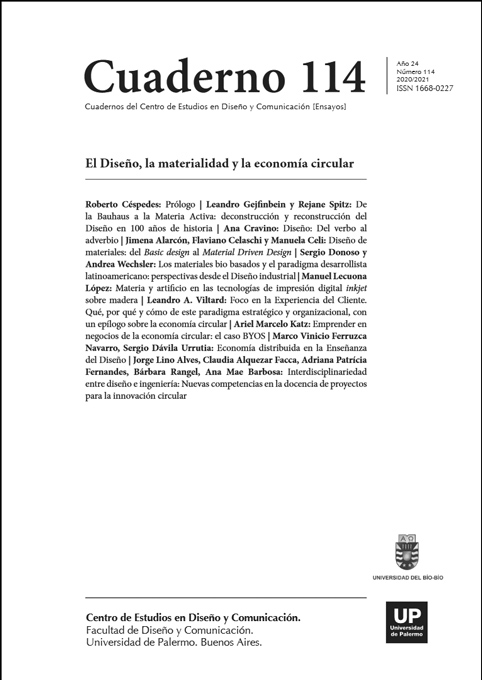Diseño de materiales: del Basic design al Material Driven Design
Abstract
This paper provides a vision regarding the design of materials as a theme of industrial design, generated from the influence of the Italian referent based on the design philosophy of Carmelo Di Bartolo. Its objective is to demonstrate the contributions of basic design linked to bionics, applied to the construction of a projective methodological approach of the observant industrial design of the materials that make up the artifices. Basic design is the method based on the observation of nature, from which designers extrapolate bionic principles towards the conception of the artificial world. The relevance is the ability to integrate contributions to the field of energy savings, material and an intrinsic commitment to the environment. Not because of having extensive economic, productive and technological resources, the creative process must be unlimited and excessive. Approaches are presented that are expressed in the integrative project process called Material Driven Design, which incorporates the concept of perceived quality to integrate functional and emotional aspects of materials. The conclusions are related to the considerations that the three aspects (Basic design, bionics, and Material Driven Design) contribute to the design process.
References
Alarcón J. (2003). Biónica y Diseño Innovativo: el sector maderero y oportunidades para la generación de nuevos materiales. Tesis magister guiada por Carmelo Di Bartolo, Concepción, Chile.
Ayala C.; Quijano, A.; Ruge, C. (2011). Los materiales como medio para estimular procesos de creación. Dearq, Revista de Arquitectura 8, p.p. 44-53.https://doi.org/10.18389/dearq8.2011.06
Bramston, D. (2010). Bases del diseño de producto 01: de la idea al producto. Barcelona: Parramón. vol. 2, p. 80. Caisse, S.; Montreuil, B. (2014). Polar Business Design. SAGE Open,January-March 2014, p.p. 1–16, p.10. https://doi.org/10.1177/2158244014522632
Camere, S.; Karana, E. (2017). Growing Materials for Product Design. In Alive. Active. Adaptive. Proceedings of International Conference on Experiential Knowledge and Emerging Materials (EKSIG June 19-20). Delft, the Netherlands, p.p. 101-115.
Di Bartolo, Carmelo. (1999). Bionica: lo sviluppo naturale nel progetto. Domus n° 818.
Di Bartolo, C. (2000). Naturaleza como modelo, naturaleza como sistema. Experimenta Revista de Diseño y Comunicación para la Empresa, n°31, p.p. 9-45.
Di Bartolo, C.; Hennicke, J.; Nachtigall, W.; Plasencia, C.; Songel, G. (2000). La naturaleza como fuente de innovación. Valencia: Editorial UPV.
Di Bartolo, C.; Montanari, R. (2004). Complejidad, diseño y sociedad. Cuadernos de Diseño Pensar/Proyectar el Futuro. Madrid: Instituto Europeo de Diseño n° 1, p.87.
Di Bartolo, C. (2017). “Una vida dedicada al Diseño.” Entrevistado por Jimena Alarcón en Design Innovation, Milán, Italia. Documento no publicado. Design Innovation and Indesit Company. (2012). Materials driven design, Il progetto Eldomat.
Design Fausto Lupetti (by Dodici Edizioni), Milano, 5-7.
Emami, J.; Tashakori, M.; Tashakorinia, Z. (2008). Bionic design in industrial design education at University of Tehran. Proceedings of E&PDE, 10th International Conference on Engineering and Product Design Education.U. P. C., Barcelona, Spain, p.p. 435-440.
Karana E.; Barati, B.; Rognoli, V.; Zeeuw van der Laan, A. (2015). Material Driven Design (MDD): A method to design for material experiences. International Journal of Design 19, n°2, p.p. 35-54.http://resolver.tudelft.nl/uuid:7359026d-57f5-4f63-9835-126c5d23baed
Karana, E.; Pedgley, O.; Rognoli, V.; Korsunsky, A. (2016). Emerging Material Experiences. The Journal of Materials and Design vol. 90, p.p. 1248–1250. https://doi.org/10.1016/j.matdes.2015.07.042
Manzini, E. (1986). La materia dell'invenzione. Milano: Arcadia edizioni.
Miralles, M.; Giuliano, G. (2008). Biónica: eficacia versus eficiencia en la tecnología natural y artificial. Scientiae Studia, 6 (3), p.p. 359-369.http://dx.doi.org/10.1590/S1678-31662008000300005
Munari, B. (1990). ¿Cómo nacen los objetos? Barcelona: Gustavo Gili.
Lefteri, C. (2007). Materials for Inspirational Design. RotoVision. East Sussex, UK.
Lodato, F. (2000). Biónica: la naturaleza como herramienta de innovación. Experimenta, Revista de Diseño y Comunicación para la Empresa, n° 31.
Parisi, P.; Rognoli, V.; Sonneveld, M. (2017). Material Tinkering. An inspirational approach for experiential learning and envisioning in product design education. The Design Journal,20: sup1. https://doi.org/10.1080/14606925.2017.1353059
Rognoli, V.; Levi, M. (2005) Materiali per il design: espressività e sensorialità. Milano: Polipress.
Los autores/as que publiquen en esta revista ceden los derechos de autor y de publicación a "Cuadernos del Centro de Estudios de Diseño y Comunicación", Aceptando el registro de su trabajo bajo una licencia de atribución de Creative Commons, que permite a terceros utilizar lo publicado siempre que de el crédito pertinente a los autores y a esta revista.


